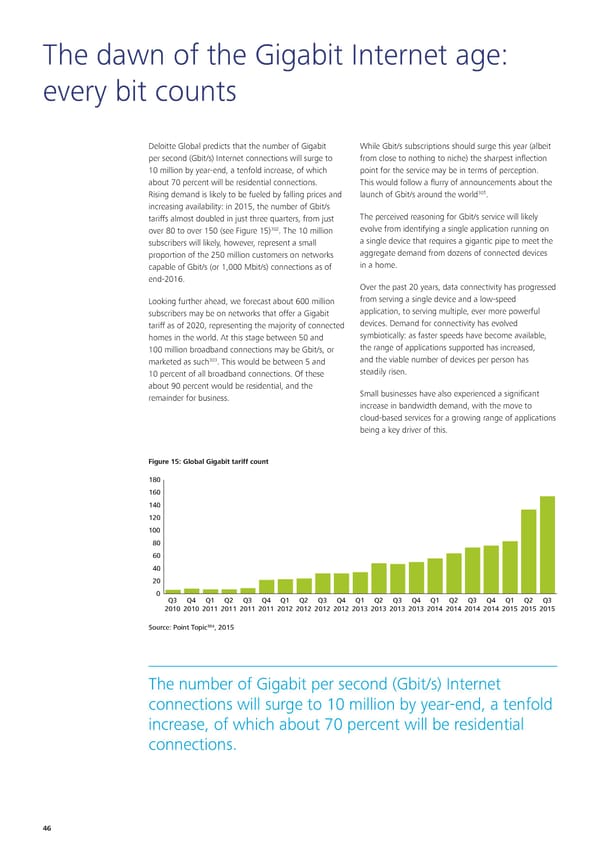The dawn of the Gigabit Internet age: every bit counts Deloitte Global predicts that the number of Gigabit While Gbit/s subscriptions should surge this year (albeit per second (Gbit/s) Internet connections will surge to from close to nothing to niche) the sharpest inflection 10 million by year-end, a tenfold increase, of which point for the service may be in terms of perception. about 70 percent will be residential connections. This would follow a flurry of announcements about the 305 Rising demand is likely to be fueled by falling prices and launch of Gbit/s around the world . increasing availability: in 2015, the number of Gbit/s tariffs almost doubled in just three quarters, from just The perceived reasoning for Gbit/s service will likely 302 evolve from identifying a single application running on over 80 to over 150 (see Figure 15) . The 10 million subscribers will likely, however, represent a small a single device that requires a gigantic pipe to meet the proportion of the 250 million customers on networks aggregate demand from dozens of connected devices capable of Gbit/s (or 1,000 Mbit/s) connections as of in a home. end-2016. Over the past 20 years, data connectivity has progressed Looking further ahead, we forecast about 600 million from serving a single device and a low-speed subscribers may be on networks that offer a Gigabit application, to serving multiple, ever more powerful tariff as of 2020, representing the majority of connected devices. Demand for connectivity has evolved homes in the world. At this stage between 50 and symbiotically: as faster speeds have become available, 100 million broadband connections may be Gbit/s, or the range of applications supported has increased, 303 and the viable number of devices per person has marketed as such . This would be between 5 and 10 percent of all broadband connections. Of these steadily risen. about 90 percent would be residential, and the remainder for business. Small businesses have also experienced a significant increase in bandwidth demand, with the move to cloud-based services for a growing range of applications being a key driver of this. Figure 15: Global Gigabit tariff count 180 160 140 120 100 80 60 40 20 0 Q3 Q4 Q1 Q2 Q3 Q4 Q1 Q2 Q3 Q4 Q1 Q2 Q3 Q4 Q1 Q2 Q3 Q4 Q1 Q2 Q3 2010 2010 2011 2011 2011 2011 2012 2012 2012 2012 2013 2013 2013 2013 2014 2014 2014 2014 2015 2015 2015 304 Source: Point Topic , 2015 The number of Gigabit per second (Gbit/s) Internet connections will surge to 10 million by year-end, a tenfold increase, of which about 70 percent will be residential connections. 46
 Technology, Media & Telecommunications Predictions Page 54 Page 56
Technology, Media & Telecommunications Predictions Page 54 Page 56